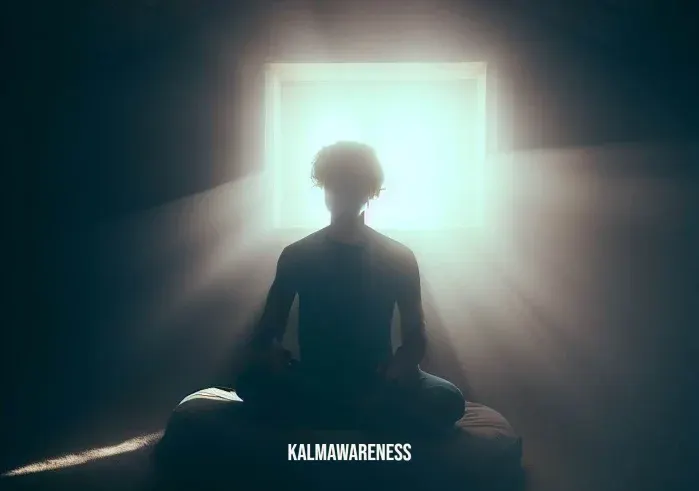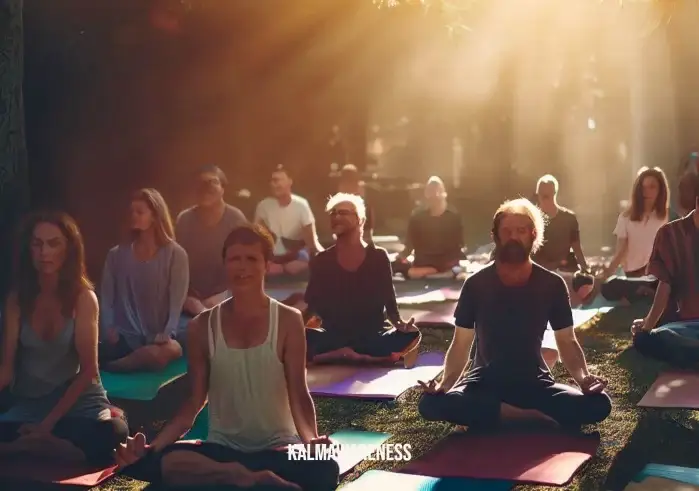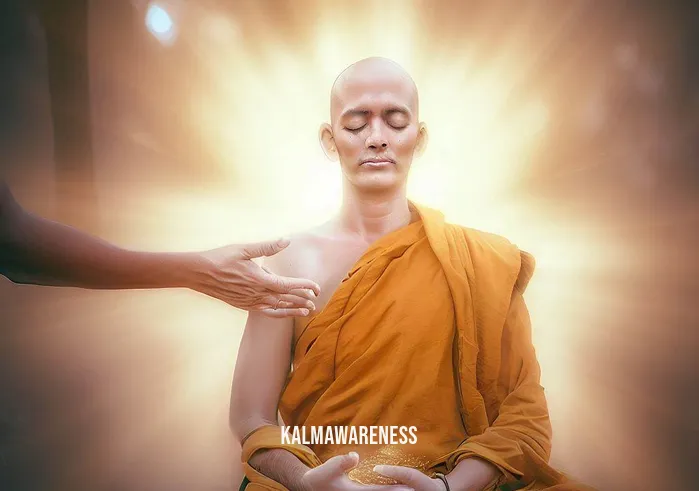Frustration Meditation: Your Pathway to Emotional Balance and Inner Calm
Feeling overwhelmed with frustration is a common, yet unproductive, state of being. It’s a labyrinth of negative emotions where we often lose ourselves. In this article, we delve into the concept of frustration meditation, a transformative practice that combines mindfulness and patience to release this unhealthy emotion, leading to stress relief and emotional balance.
Introduction to Frustration Meditation
Frustration meditation is a potent method that can help us manage and overcome the overwhelming feelings of frustration. It’s based on meditation and mindfulness techniques designed to help us develop a more balanced emotional state and cultivate calm in our daily life.
This practice is like turning the key to unlock the full body relaxation that our bodies and minds need. As we learn to manage our feelings of frustration through meditation, we embrace an antidote to adrenal fatigue, as meditation for adrenal fatigue can be a lifeline for those feeling chronically stressed and overwhelmed.
Unraveling the Frustration Knots: A 6-Step Meditation
To get started with frustration meditation, let’s follow a simple 6-step meditation process.
- Recognition: Acknowledge the presence of frustration within you. Observe the emotions without judgment.
- Understanding: Try to understand the cause of your frustration. What triggered it? Is it an internal or external factor?
- Emotional Acceptance: Allow yourself to feel the frustration, accepting it as a natural emotional response.
- Breathing: Now, focus on your breath. Notice the inhale and the exhale, the rise and fall of your chest.
- Letting Go: With each exhalation, imagine releasing a little bit of your frustration.
- Kindness: Finally, direct kindness and compassion towards yourself.
These steps are an integral part of the meditation process, just as they are in yoga. They echo the philosophy of living the process in yoga.
“Meditation is not evasion; it is a serene encounter with reality.” – Thich Nhat Hanh
Why Do We Experience Frustration?
Understanding frustration begins with acknowledging that it often arises from unmet expectations, a feeling of powerlessness, or persistent challenges. We often run out of patience when things don’t go our way or when we feel unable to change the circumstances leading to frustration.
Managing frustration is paramount for health and wellbeing. In our quest to find calm amidst chaos, it becomes necessary to trust the process and acknowledge that all we can do is try.
Sometimes, frustration can escalate to the point where we feel like we’re the most patient person but our patience is running thin. This is when frustration meditation can truly come to our rescue, guiding us to find balance and cultivate patience.
Frustration and Its Impact on Mental Health
Frustration isn’t just an uncomfortable emotional state – it can also take a toll on our mental health. In fact, chronic frustration can lead to increased stress and anxiety. Our article, this is my brain on anxiety, explores how sustained emotional strain can negatively affect our brain’s functioning.
Being able to stop stress this minute is crucial for our overall health and wellbeing. This is where the beauty of frustration meditation comes into play, offering a tool to diffuse the ticking time bomb of frustration before it impacts our mental health.
By learning the art of frustration meditation, you can achieve emotional balance, inner calm, and improved mental wellbeing. But that’s just the beginning! In the next part of this article, we’ll dive deeper into the different meditation techniques and their roles in alleviating frustration.
We invite you to continue to the second part of this article, where we will delve deeper into the techniques of frustration meditation and the science behind its effectiveness. Stay tuned to discover how you can incorporate this powerful practice into your daily routine.

Advancing with Frustration Meditation: Techniques and Benefits
As we progress into our exploration of frustration meditation, it’s imperative to delve into specific techniques that can aid us on this journey of self-discovery and transformation. This second part of the article aims to guide you on these effective methodologies and their associated benefits.
Techniques of Frustration Meditation
There are several techniques to perform frustration meditation. Each one is unique and holds the potential to help us cope with and resolve feelings of frustration. Here are a few key methods you might find helpful:
- Alpha Waves Meditation: This technique uses the power of alpha brain waves, which are linked to calmness and creativity. By harnessing alpha wave activity, we can move from a state of frustration to a state of peace.
- Anapana: An ancient technique of meditation, Anapana focuses on the observation of natural, normal respiration, helping us to cultivate mindfulness and patience.
- Body Scan Meditation: This method requires us to focus on different parts of our bodies, systematically relaxing each one. This can distract from feelings of frustration and promote relaxation.
- Anchor Breathing: This technique uses the breath as an ‘anchor’ to ground us in the present moment, diverting our focus from frustrations and redirecting it towards a calm and balanced state.
Benefits of Frustration Meditation
By practicing these techniques, we not only find a way to cope with frustration but also harness numerous other benefits:
- Stress Reduction: Meditation reduces the production of stress hormones and promotes a relaxation response, providing relief from chronic stress. Read more in our Mindfulness-Based Stress Reduction Workbook.
- Improved Patience: Regular practice can help cultivate patience and tolerance, preventing us from running out of patience quickly.
- Emotional Balance: Frustration meditation allows us to remain balanced during emotional upheavals, leading to an absolute peace.
- Enhanced Focus and Concentration: By centering our attention on the present moment, meditation can enhance our focus and concentration.
- Better Sleep: By reducing stress and promoting relaxation, frustration meditation can improve sleep quality, a key factor for overall well-being.
Brief Meditation Techniques to Overcome Frustration
For those pressed for time, we have curated brief yet effective meditation practices that you can incorporate into your daily routine:
| Technique | Duration | Benefits |
|---|---|---|
| 2-minute meditation | 2 minutes | Quick stress relief, instant calmness |
| 5-minute silent meditation | 5 minutes | Improved focus, stress relief |
| 12-minute guided meditation | 12 minutes | Enhanced mindfulness, anxiety reduction |
| 15-minute guided meditation for anxiety | 15 minutes | Anxiety relief, improved mental clarity |
| 20-minute meditation for anxiety | 20 minutes | Deep relaxation, enhanced emotional control |
The Role of Patience in Frustration Meditation
While practicing frustration meditation, it’s crucial to understand that this is a process that takes time. As we often say, patience is running thin, but this practice encourages us to cultivate patience. This technique requires consistency, so it’s essential to be patient with ourselves.
We encourage you to stop the stress acronym survival mode and embrace the transformative power of patience through frustration meditation.
In this second part of our article, we’ve explored the various techniques and benefits of frustration meditation. As we proceed to the third part, we’ll delve into the science behind this effective practice, helping you understand why and how it works. We invite you to continue this enlightening journey with us to unlock a new level of emotional balance and inner calm.

Frustration Meditation: Scientific Basis and Inspirational Quotes
As we move further into our exploration of frustration meditation, we discover how this practice is not just a spiritual pursuit, but is also rooted in solid scientific principles. This chapter also presents a series of inspirational quotes that resonate with our journey towards understanding and mastering frustration meditation.
Scientific Understanding of Frustration Meditation
Frustration meditation operates based on several fundamental scientific principles. Here are some key aspects:
- Neuroplasticity: Meditation can physically reshape our brains over time. Regular practice of frustration meditation has been shown to rewire an anxious brain, making it more resilient to stress and frustration.
- Stress Response Reduction: Chronic frustration triggers our body’s stress response, leading to harmful physical effects. Frustration meditation helps us manage stress, reducing these detrimental impacts.
- Emotion Regulation: Neuroscience reveals that frustration meditation can help regulate our emotions, assisting us to become calm and composed even in frustrating situations.
- Mind-Body Connection: Frustration meditation aids in reinforcing the mind-body connection, leading to overall improved health and wellness.
Inspirational Quotes on Frustration and Meditation
The following quotes, steeped in wisdom, provide valuable insights into the art of transforming frustration through meditation:
- “Peace comes from within. Do not seek it without.” – Buddha
- “Frustration, although quite painful at times, is a very positive and essential part of success.” – Bo Bennett
- “In the process of letting go, you will lose many things from the past, but you will find yourself.” – Deepak Chopra
- “The greatest weapon against stress is our ability to choose one thought over another.” – William James
- “If you want to conquer the anxiety of life, live in the moment, live in the breath.” – Amit Ray
The Role of Breathing in Frustration Meditation
Breathing plays a vital role in frustration meditation. As Thich Nhat Hanh rightly said, “Feelings come and go like clouds in a windy sky. Conscious breathing is my anchor.”
Consider the following breathing techniques:
- Flower and Candle Breathing: A unique breathing exercise that aids in calming your mind and managing feelings of frustration.
- Float Meditation: This involves controlled breathing and visualization, floating your frustrations away.
- Equanimity Phrases: Breathing techniques combined with calming phrases can help achieve balance and dissipate frustration.
Incorporating Frustration Meditation into Daily Life
Incorporating frustration meditation into our daily lives can be a transformative process. From meditating after work to practicing it when you’re anxious for nothing, there are multiple ways to include this beneficial practice in our routine.
Also, remember that practicing frustration meditation is a process, not an event. It’s not about waiting for someone to change, but about trusting the process and working consistently towards change.
In this chapter, we’ve uncovered the scientific basis behind frustration meditation and how its practice can be woven into our daily lives. As we proceed to the fourth part, we will explore how to maintain consistency and focus in your meditation practice over time. We encourage you to continue this enlightening journey with us.

Frustration Meditation: Hope-Inspiring Quotes and Effective Techniques
As we continue our exploration of frustration meditation, let’s delve into some hope-inspiring quotes that emphasize the transformative power of meditation. Additionally, we’ll be introducing various techniques that could enrich your frustration meditation experience.
Quotes of Hope and Confidence in Frustration Meditation
Here are some poignant quotes that express the power of meditation in transforming frustration into a springboard for growth:
- “You should sit in meditation for 20 minutes a day, unless you’re too busy; then you should sit for an hour.” – Old Zen Saying
- “Frustration is a sign I am acting independently. The more you try your own way, the tighter the doors will stay closed.” – Joyce Meyer
- “Meditation can reintroduce you to the part that’s been missing.” – Russell Simmons
- “Do not let the behavior of others destroy your inner peace.” – Dalai Lama
- “Every frustration is an opportunity for an amazing breakthrough.” – Jim Kwik
Techniques for Effective Frustration Meditation
- Informal Meditation: Practicing mindfulness during day-to-day activities can enhance your ability to handle frustration. It’s about bringing full awareness to what you’re doing at any given moment.
- Meditative Martial Arts: Techniques derived from martial arts can help manage frustration effectively. It involves utilizing the energy of frustration towards purposeful movement.
- Body Scan Meditation: It involves mentally scanning each part of your body, releasing tension and fostering calmness.
- Alpha Wave Meditation: This technique promotes relaxation and creativity, reducing feelings of frustration.
- Meditation for Brain Fog: Brain fog, often linked to frustration, can be mitigated through specific meditation techniques.
Comparing Frustration Meditation Techniques
To give you a better understanding, let’s compare these techniques in the table below:
| Technique | Benefits | Difficulty Level |
|---|---|---|
| Informal Meditation | Increases mindfulness and presence | Easy |
| Meditative Martial Arts | Harnesses frustration into purposeful movement | Moderate |
| Body Scan Meditation | Reduces tension and fosters calmness | Easy |
| Alpha Wave Meditation | Promotes relaxation and creativity | Moderate |
| Meditation for Brain Fog | Clears mental clutter and enhances focus | Moderate |
Making Frustration Meditation a Habit
Forming a habit of frustration meditation is the key to reaping its long-term benefits. Whether it’s a brief meditation on breath, a 5-minute silent meditation, or a 20-minute guided meditation for anxiety, make sure to include this practice in your routine.
In this chapter, we’ve looked at how meditation can instill hope and confidence, particularly in managing frustration. As we approach the final part of our exploration, we will dive into some common challenges that individuals often face while practicing frustration meditation and how to overcome them. Let’s continue on this enlightening path.

Frustration Meditation: Overcoming Common Challenges and Nurturing a Balanced Emotional State
Navigating the path of frustration meditation may sometimes be challenging, but understanding these hurdles can immensely help in overcoming them. So, in this final chapter, we will explore common obstacles that individuals often encounter and solutions to these problems.
Understanding Frustration in Meditation
Frustration during meditation is a common experience. It is a form of resistance that emerges when our current experience differs from our expectations or desires. Sometimes, you might feel like you’re not making any progress, or you might struggle with maintaining focus. There are many strategies for managing stress and wellbeing, and understanding the source of your frustration is a crucial first step.
Challenges in Frustration Meditation
- Excessive Self-Judgment: It’s easy to fall into the trap of judging your meditation skills harshly, especially if you’re anxious for nothing. Remember that meditation isn’t a competition; it’s a journey of self-discovery.
- Lack of Consistency: Developing a consistent meditation practice can be challenging, especially when you feel like you’re running out of patience. Try incorporating shorter meditation sessions into your daily routine, like a 2-minute meditation, and gradually increase the time as you become more comfortable.
- Physical Discomfort: Physical discomfort during meditation can be frustrating. Choose a comfortable position and try full-body relaxation techniques to alleviate physical tension.
Achieving Emotional Balance Through Frustration Meditation
Frustration meditation can significantly contribute to emotional balance. By transforming our relationship with frustration, we not only learn to cope with this emotion but also foster a sense of inner calm and resilience.
Consider the practice of Anapana, which focuses on the natural inhalation and exhalation of breath. This technique promotes tranquility and sharpens the mind, helping you manage frustration more effectively.
Remember, practicing patience is an integral part of meditation. If you find your patience running thin, remind yourself that progress in meditation doesn’t always follow a linear path. It’s a process, and trusting the process is essential.
Our exploration of frustration meditation comes to an end with this chapter. I hope that the insights and suggestions provided throughout this article will support you in your journey towards mastering frustration through meditation. Remember, the journey of meditation is one of personal growth and discovery, and every step you take is a step towards greater understanding and tranquility. Thank you for embarking on this journey with us.

Frustration Meditation: A Path to Lightness, Relief, and Inner Harmony
Frustration meditation doesn’t just mean sitting silently with your eyes closed, it’s a journey of self-discovery, a practice that cultivates patience, and a tool that promotes emotional balance. As we conclude this exploration into the heart of frustration meditation, let’s lighten the mood and reflect on the beauty, relief, and harmony that this practice can bring into our lives.
A Lighter State of Being with Frustration Meditation
Imagine living a life where frustration is not a debilitating force but a catalyst for personal growth. Frustration meditation can be that transformative practice that fosters a lighter, more liberated state of being. From aiding in managing stress to encouraging a state of absolute peace, the benefits are immense and truly life-changing.
Frustration Meditation and Relief from Stress
One of the most wonderful outcomes of a regular frustration meditation practice is the relief it offers from stress. Our mindfulness-based stress reduction workbook can help guide you in utilizing frustration meditation to manage stress effectively.
Moreover, engaging in a 15-minute guided meditation for anxiety can further enhance your sense of relief, providing a well-deserved respite from your daily worries.
The Harmonizing Power of Frustration Meditation
Beyond mere stress relief, frustration meditation has the power to harmonize our emotional landscape. If you’ve been feeling like your patience is running thin, a 20-minute meditation for anxiety can help restore emotional balance and promote a sense of inner harmony.
As we conclude this final chapter, it is my hope that you now view frustration not as an adversary, but as a teacher. Frustration meditation is indeed a powerful tool to foster patience, cultivate calmness, and maintain emotional balance. As you continue your journey, remember the words of the renowned meditation teacher, Sharon Salzberg, “Meditation is the ultimate mobile device; you can use it anywhere, anytime, unobtrusively.”
Thank you for joining us in this exploration of frustration meditation. Be sure to explore our Meditation Magazine Subscription for more insightful articles and helpful guides to support you in your meditation journey. As we part ways, I wish you success, lightness, and tranquility. Keep meditating, keep growing, and remember, every step forward, no matter how small, is a step towards a more balanced and harmonious life.





